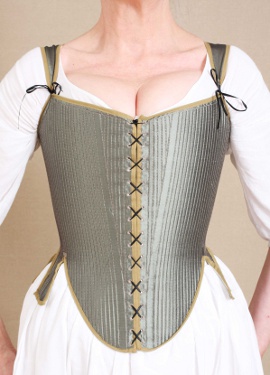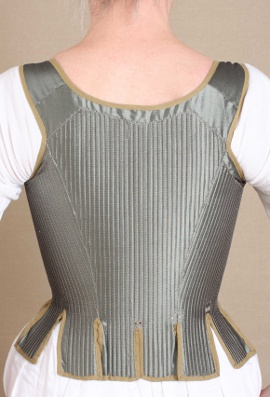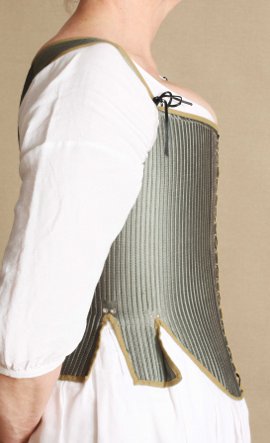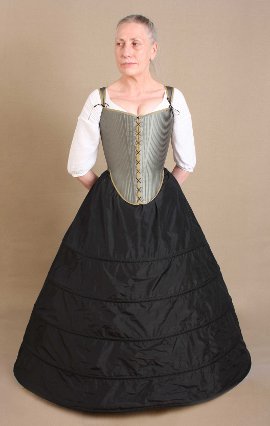
'Effigy' Style Bodies or Stays c. 1603
Following normal royal practice, when Queen Elizabeth I died in 1603, an effigy was made of the monarch to be carried in the funeral procession, lying on top of the coffin. After the funeral the effigy was placed with the other effigies of dead English kings and queens on public show in Westminster Abbey.
In 1994, the renowned Elizabethan clothing expert and costume historian Janet Arnold was able to view the stays when the effigy underwent conservation.
Despite the effigy having been redressed in 1760 with new clothes and an 18th century hoop petticoat, Miss Arnold was of the opinion that the stays were indeed the pair originally put on the effigy in 1603. These stays are therefore the earliest known survival of this type of garment in England. Stylistically they are very similar to later pairs that survive from the early and mid 17th century in English public and private collections.
 In the Elizabethan period this garment would not have been referred to as stays but instead was termed a 'pair of bodies' or simply 'bodies'.
In the Elizabethan period this garment would not have been referred to as stays but instead was termed a 'pair of bodies' or simply 'bodies'.
It is highly unlikely that the original effigy bodies would have ever been worn by Elizabeth since they are very simply made of two layers of twill weave fustian and it is known from wardrobe accounts that Elizabeth had bodies of silk or silk brocade.
I needed a pair of bodies for a lecture for The Early Dance Circle in early 2008. It was the first time I had made Effigy style bodies and I am pleased with how they came out.
Since I was using them in front of a lecture audience I decided to use a silk taffeta in a subtle green/grey shade. I did however keep to the original 2 layer construction with 4mm wide artificial whalebone inserted into channels. After years of making 18th century stays where there can be up to 6 layers of fabric I was uncertain of this apparently flimsy construction, yet in wear it works very well.
 At present my version is worn with a separate busk of metal between the bodies and the shift. It is possible that originally there may have been a separate stomacher or busk of stitched fabric and bones under the opening to hold the shape and prevent any flesh being pinched between the laces and front edges.
At present my version is worn with a separate busk of metal between the bodies and the shift. It is possible that originally there may have been a separate stomacher or busk of stitched fabric and bones under the opening to hold the shape and prevent any flesh being pinched between the laces and front edges.
Many people on the web have made this type of stay and have over exaggerated the length of the busk point over the belly. In reality, the front length of the original is only 42 cm or 16 1/2". This length divides approximately equally above and below the waist line.
The busk point therefore only reaches to about 20 cm below the waist, a comfortable and non invasive level for it to end, whilst still giving the characteristic late Elizabethan long body shape.
 Here the stays are worn with a black silk taffeta farthingale made from the Alcega description of 1589. I have slipped the front waistline of the farthingale under the busk point of the stays as far as the first tab and then over the tabs at the sides and back to allow for fastening.
Here the stays are worn with a black silk taffeta farthingale made from the Alcega description of 1589. I have slipped the front waistline of the farthingale under the busk point of the stays as far as the first tab and then over the tabs at the sides and back to allow for fastening.
Although this farthingale looks as though it is touching the floor it is actually some inches shorter. It is unclear from contemporary images if the Tudor farthingales were floor length or not.
